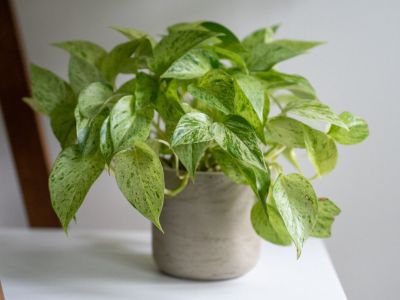About Variegated Pothos
Pothos is popular in the home for several reasons. Pothos plants grow quickly and produce pretty vines in a range of colors, sizes, and patterns. They are among the easiest houseplants to grow. If you’re someone who tends to forget to water your plants, this is the plant for you. While pothos is a vine, it doesn’t need a structure to climb. You can train it to something and let it grow up to 30 feet (9 m.) long, or just let it trail and trim to whatever length you like. All types of pothos, variegated included, prefer bright, indirect light. They’ll tolerate low-light conditions and even a lack of windows, if there are interior lights. Just be aware that you can lose some of the variegation in leaves in lower light conditions. The soil should drain well and dry out between waterings. High humidity is best.
Epipremnum aureum Variegated Pothos Types
Pothos’ botanical name is Epipremnum aureum, and there are multiple cultivars with varying appearances, including those with striking variegation. Pothos is both a good place to start for a beginner houseplant collector and an opportunity to find unique and rare types. Some of the most attractive pothos plants have striping or variegation. If interesting patterns catch your eye, try some of these pothos cultivars:
‘Marble Queen.’ This is one of the most common types and is a white variegated pothos, and it’s easy to find too. The variegation is green and cream. In low light the cream coloring can turn yellowish. ‘Golden.’ Also popular is variegated ‘Golden’ pothos. It has variegated leaves with green and a golden yellow. ‘Tricolor.’ A little harder to find, ‘tricolor’ has green, white, and cream with uniquely white stems. It has more white coloring than other varieties. ‘Pearls and Jade.’ This is a newer, small variety of pothos. The leaves are only about 2.5 to 3 inches (6-8 cm.) long. ‘Marble Queen’ is the parent plant to this cultivar, and they have similar variegation. The leaves on ‘Pearls and Jade’ are white and green like ‘Marble Queen,’ but also have some gray coloring and a more irregular pattern. ‘Manjula.’ Both this cultivar and ‘Pearls and Jade’ were created by the University of Florida. ‘Manjula’ can be hard to find but is worth the hunt for its striking cream, green, and white foliage. ‘Brasil.’ This unique variety is named for the fact that the leaves resemble the Brazilian flag. They are dark green splashed with a lighter, greenish yellow color. The color blocks are larger than in some other varieties. ‘Global Green.’ For unique green-on-green variegation, look for this newish cultivar. ‘Global Green’ has typically darker green leaves and edges, with slightly lighter green variegation in the centers of the leaves. ‘Harlequin.’ This is among the rarest of pothos cultivars, so be prepared to hunt and fork over serious money for ‘Harlequin.’ Some people believe it is simply a variation on ‘Manjula.’ Whether this is true or not, it’s a striking plant with big blocks of white on green leaves.
Another plant often called pothos isn’t really the same species. Still, Scindaspus pictus, also known as silver or satin pothos, look similar and provides another variegated option. It grows more slowly than true pothos, but it has green and silvery variegation.
